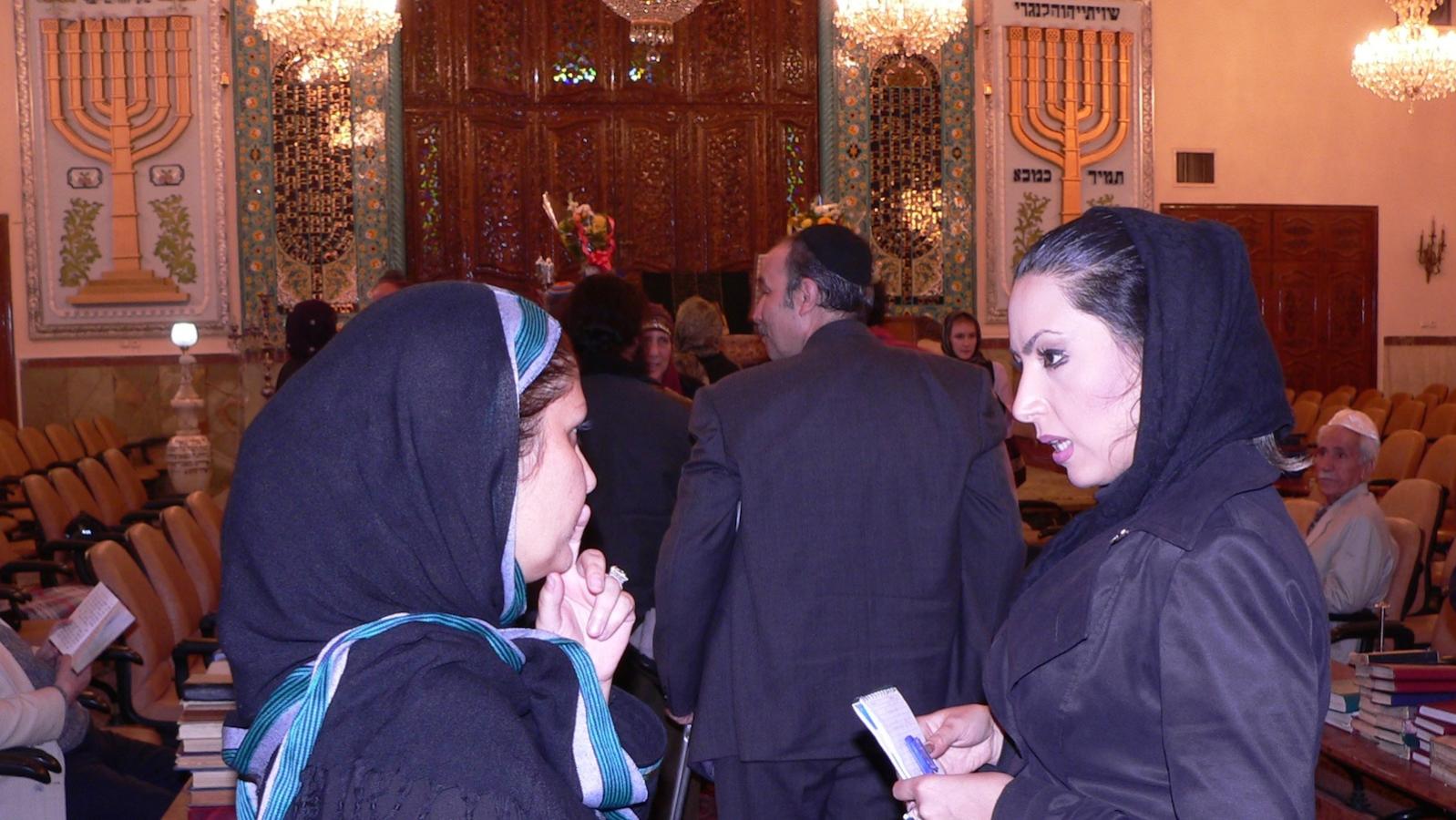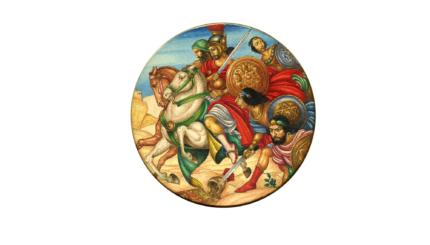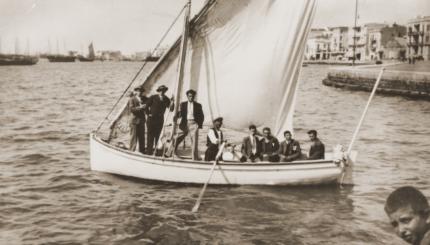Jews began settling in Iran about 2,700 years ago. Throughout their history, the Iranian Jews have coped with significant challenges, especially during the Safavid era (1501-1736) and under the Qajar rulers (1796-1925).
The years of the Pahlavi dynasty, however — especially the reign of Muhammad Reza Shah (1941-1979) — are often considered a “Golden Age” for Iranian Jewry. The Iranian Jewish community thrived economically under the Shah’s reform plan, the “White Revolution” (1964-1979). The White Revolution’s rapid modernization provided exceptional opportunities for the Jewish community in Iran.
On the eve of the Islamic Revolution in 1978, the Jewish community in Iran numbered around 80,000 with 60,000 living in the capital, Tehran. Although the Jews constituted less than a quarter of a percent of the total Iranian population of 35 million, their economic, professional, and cultural impact on the country was great.
At this time, the vast majority of the Jewish population in Iran was middle class or upper middle class. There were Jewish schools, active social and cultural organizations, and about 30 synagogues in Tehran alone.

Help us keep Jewish knowledge accessible to millions of people around the world.
Your donation to My Jewish Learning fuels endless journeys of Jewish discovery. With your help, My Jewish Learning can continue to provide nonstop opportunities for learning, connection and growth.
The Islamic Revolution
With the outbreak of opposition to the Shah in the autumn of 1977, what had been considered the strength of the Jewish community quickly transformed into its principal weaknesses: its socio-economic status, identification with the Shah and his policies, and ties to Israel and the United States.
Expressions of anti-Jewish animosity soon intensified. In Tehran, pamphlets were circulated threatening to take revenge upon the Jews for plundering Iran’s treasures. Slogans scribbled on the walls of synagogues and Jewish institutions proclaimed “Death to the Jews.” Iranian Muslims began ostracizing their Jewish neighbors, whose newfound insecurity and desire to liquidate their property was met with hostile responses.
During the revolution itself, a wave of anti-Israel sentiment swept over Iran, impacting the Jewish community. Private wealth was confiscated on a large scale, which sent thousands of affluent Jews fleeing to the United States or Israel.
But at the same time, Jews were optimistic about the regime change. When Ayatollah Khomeini — a senior Shi’a Muslim cleric and the future Supreme Leader of the country, returned to Iran on the February 1, 1979, 5,000 Jews, led by Iranian Chief Rabbi Yedidia Shofet, were among those welcoming him. Some of them held pictures of Khomeini and signs proclaiming: “Jews and Muslims are brothers.”
On May 14, 1979, five days after the execution of Jewish community head Habib Elghanian, who was accused of Zionist espionage and activities, a delegation of Jewish leaders set out for Qom to meet with Khomeini, who allayed their fears with the following words:
We make a distinction between the Jewish community and the Zionists–and we know that these are two different things. We are against [the Zionists] because they are not Jews, but politicians…but as for the Jewish community and the rest of the [minority] communities in Iran–they are members of this nation. Islam will treat them in the same manner as it does with all other layers of society. (Radio Tehran, May 15, 1979)
Indeed, since the establishment of the Islamic Republic and its declaration of Islam as the all-encompassing state religion in 1979, the regime has officially distinguished between the Jews of Iran, considered loyal citizens, and other Jews — Israelis, Zionists and world Jewry, toward whom the regime did not conceal its hostility. Zionist activity was made a crime, punishable by severe penalties.
This brought about changes in internal Jewish communal affairs. At the end of March 1978, a new generation of progressive Jewish Iranian intellectuals supplanted the old Jewish council, Anjumān-i Kalīmīan (Jewish Committee), with the founding of the anti-Zionist radical Jāme-yi Rowshanfikrān-i Yahūd-i Irān (The Organization of Iranian Jewish Intellectuals), whose platform included full support of the Islamic Revolution of 1979, religious and cultural revival, and community protection. Since its founding this organization has struggled to preserve the community from disintegration.
Leaving Iran
Indeed, the revolution aroused fears among Iranian Jews and around two thirds of the community left the country. The emigrants included the majority of the community’s leaders, philanthropists and professionals. According to estimates, 30,000-40,000 Iranian Jews emigrated to the United States, 20,000 to Israel, and 10,000 to Europe, notably the United Kingdom, France, Germany, Italy, and Switzerland. Of those Iranian Jews who made their way to the United States, around 25,000 live in California (20,000 in Los Angeles alone) and 8,000 live in the New York area. Today, the number of Jews still residing in Iran is estimated at between 25,000 and 30,000.
Jews who wished to emigrate during the first decade and a half of the Islamic republic encountered many problems as the special government office responsible for granting passports to Jews refused numerous applicants. Many Jews ended up fleeing through Pakistan or Turkey. These emigrants often left most of their property behind, under the assumption that their relatives would liquidate the assets. But even when this did happen, it was very difficult to send the money abroad.
Jewish Life in Iran
In many ways, the revolution was also a revolution in the lives of Persian Jews. The new leaders of Iran sought to create a country modeled after their particular perception of the ideal Islamic society; it was inevitable that this model would affect the lives of religious minorities.
While Islam’s attitude towards other monotheistic faiths is, in principle, a fairly tolerant one, the writings and speeches of Ayatollah Khomeini and those close to him are full of vitriolic denunciations of Jews. Unlike the Pahlavi regime, which placed nationalism as its highest priority and saw Jews as equals, Khomeini’s Islamic doctrine forced Jews into a position of inferiority vis-à-vis the Muslim majority.
Despite his supposed distinction between Jews and Zionists, Ayatollah Khomeini’s doctrine contained anti-Jewish elements, including an emphasis on Shi’ite doctrine pertaining to the impurity (najasat) of non-Muslims. According to traditional Islamic law, religious minorities are impure elements that pollute the Shiite believers with whom they come into contact. Historically, najasat was highly influential in governing daily relations between Jews and Shi’ites. In his writings, Khomeini also attacked the Jews and accused them of distorting Islam, mistranslating the Koran, and taking over Iran’s economy.
Still, official recognition of minorities was rooted in the Iranian constitution: Zoroastrian, Jewish and Christian Iranians are the only recognized religious minorities who, within the limits of the law, are free to perform the religious rites and ceremonies and to act according to their own canon in matters of personal affairs and religious education. Within this framework, the Jewish minority was guaranteed permanent representation in the Iranian parliament. The constitution also dictates that the Islamic Republican government and Iranian Muslims must treat non-Muslims according to Muslim principles of ethics and justice.
In practice, Jewish freedom of worship has not been limited in a meaningful way, and to this day Jewish holidays receive coverage in the media. Each year, local television stations broadcast programs on Jewish holidays — especially Passover, when the state media carries the blessings of the Jewish community head and Majles representative. The community has continued administering its own schools, synagogues and other institutions, including Jewish hospitals, nursing homes, cemeteries, and libraries.
Today, Jews participate in Iranian civic and political life. Many Jews join the Iranian masses in protesting the State of Israel on the annual “Qods Day” (Jerusalem Day), and during the Iran-Iraq war (1980-1988), Iranian Jews supported the war effort by donating ambulances and surplus goods as well as making hospital visits. Some Jewish youth even took part in the fighting and were wounded in combat.
Anti-Semitism, however, remains. In 1999, 13 Jews from Shiraz and Isfahan were arrested on charges of spying for Israel, and they were convicted in 2000. By February 2003 all of them had been released, but the arrests planted fear in the heart of the Jewish community, bringing its loyalty under question.
Despite all these difficulties, most of the remaining Jews of Iran feel an unbreakable bond to their homeland and continue to live there. In a gathering of Iranian Jews in Shiraz at the end of 2002, several months after the release of some of the detainees, one of the leaders of the Jewish community made the following speech:
“We are not the same subdued people as before. We are alive, joyful, active and Iran-lovers. We’ve been inhabitants of Iran for the past 2,700 years … and Iran is our native country. We are essentially Iranians first and then Jews. We are proud to be Iranians. Long live Iran. Long live Iranians Jews.” (From the movie “Jews of Iran,” directed by Ramin Farahani)



